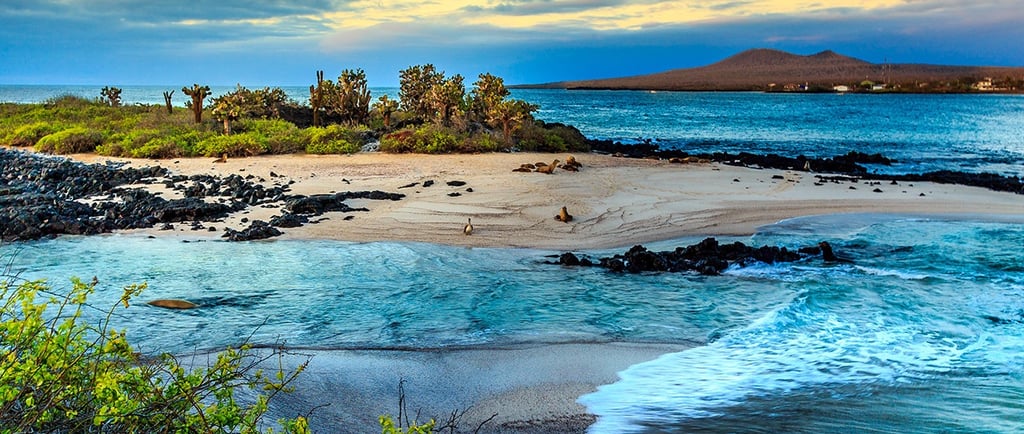The Galapagos Archipelago Marine Reserve: an exportable model for ecosystem conservation ?
AMERICA
Thomas Dos Remedios
7/10/20255 min read


Isolated off the coast of Ecuador, the Galapagos archipelago has become much more than a backdrop for iguanas and hundred-year-old turtles. Its marine reserve, expanded in 2022, is now one of the largest and most emblematic in the world. With its endemic species, multi-stakeholder management and measurable ecological results, it is often held up as a success story. But can this success be replicated elsewhere, in more populated, more disputed or less stable contexts? The Galapagos case deserves a detailed analysis, combining biology, environmental governance and ocean geopolitics.
A PIONEERING MARINE RESERVE, BORN OF AN ARCHIPELAGO UNIQUE IN THE WORLD
Created in 1998, the Galapagos Marine Reserve initially covered more than 133,000 km², around the eponymous archipelago located around 1,000 kilometres off the coast of Ecuador. In January 2022, at the COP in Glasgow, Ecuador announced the extension of the reserve to 198,000 km², with the creation of the ‘Hermandad Corridor’: a protected area linking the Galapagos to Cocos Island (Costa Rica), in coordination with the governments of Colombia and Panama. This marine territory is home to an exceptional concentration of biodiversity: some 2,900 marine species, around 25% of which are endemic, meaning that they are found nowhere else. Hammerhead sharks, manta rays, giant tortoises, marine iguanas, sea lions, deep-water corals... the Galapagos form an ecosystem that is almost insular in the biological sense of the term, where evolution follows its own laws.
This richness is the result of specific geo-oceanographic conditions. Three marine currents (the warm Panama Current, the cold Humboldt Current and the South Equatorial Current) converge around the archipelago, creating highly diverse habitats in a small area. What's more, the low level of industrialisation and the absence of major ports have limited the massive pollution found elsewhere. But the uniqueness of the Galapagos lies not only in their fauna: their symbolic value has been affirmed since the 19th century, thanks in particular to Charles Darwin, who developed his theory of natural selection here. This scientific and heritage aura has reinforced their status as a global ecological sanctuary.
EXPERIMENTAL AND COLLABORATIVE GOVERNANCE AT THE HEART OF SUCCESS
While the ecological results are impressive, they are far from due to geographical isolation alone. The decisive factor lies in a pioneering model of environmental governance that brings together the Ecuadorian government, researchers, international NGOs, local communities and tourism operators. The heart of this system is the Parque Nacional Galápagos (PNG), a public institution responsible for environmental monitoring, regulation and education. It acts in coordination with the Fundación Charles Darwin, which produces the scientific research needed for the adaptive management of the reserve. Maritime Surveillance relies on a system of radar, satellites, drones and patrol teams to detect intrusions and poaching.
The National Park Management Board includes representatives from the government, artisanal fishing, tourism, research and NGOs. This multi-stakeholder structure allows for more flexible management that is better accepted by local populations. In particular, it includes small-scale fishermen, who benefit from limited but guaranteed fishing zones in exchange for strict compliance with quotas and fishing seasons. As for tourism - the archipelago's main source of revenue - it is strictly controlled: only certain itineraries are authorised, guides must be accredited, and each visitor pays an entry tax (up to 100 dollars for foreigners). In 2023, almost 270,000 tourists visited the islands, for a local population of around 30,000. While this figure may seem high, it remains well within the limits of the numbers recorded in other marine protected areas around the world.
MEASURABLE ECOLOGICAL RESULTS, BUT CONSTANT VIGILANCE
One of the rare cases where marine conservation is not limited to symbolic promises, the Galapagos reserve is showing tangible results. Scientists have observed a gradual repopulation of certain species of shark and ray, the maintenance of large populations of healthy coral, and a decline in illegal fishing in the most closely monitored areas. Studies carried out by the Charles Darwin Foundation, for example, indicate a stabilisation in hammerhead shark populations, a globally threatened species, and greater genetic diversity in certain areas of the Hermandad corridor, where migratory species can move freely. The creation of this corridor is a response to the need for ecological connectivity, based on the free movement of pelagic species (tuna, turtles, marine mammals) through interconnected protected areas.
But this success remains fragile. On the periphery of the reserve, industrial fishing fleets, notably Chinese, operate on the legal limit, just a few kilometres from the protected area. In 2020, a Chinese vessel was intercepted carrying more than 6,000 sharks (including many protected species), provoking a diplomatic crisis. Illegal incursions are a regular occurrence, and the Ecuadorian government has only limited resources to ensure continuous surveillance of this immense zone. Other threats include plastic pollution from Asia and Central America, demographic pressure on certain inhabited islands (Santa Cruz, San Cristóbal), and the risk of proliferation of invasive species such as wildcats, ornamental plants and certain algae accidentally introduced by human transport.
BETWEEN EXEMPLARITY AND THE LIMITS OF TRANSPOSITION
There is a great temptation to present the Galapagos reserve as an exportable model. Its effectiveness seems to have been demonstrated, its model of governance is setting an example and its image inspires confidence. Yet specialists remain cautious about transferring this model elsewhere. The Galapagos benefit from a set of conditions that are rarely found together: geographical isolation, low population pressure, economic dependence on tourism (and therefore an interest in preserving its image), relatively stable democratic governance and international financial support. Few coastal regions combine these advantages.
Conversely, most of the areas where marine biodiversity is under threat are located in fragile geopolitical contexts, with very marked conflicts of use. The Gulf of Guinea, for example, is under intense pressure from illegal fishing and maritime trafficking, with states that have little capacity to monitor their exclusive economic zones. In South-East Asia, initiatives such as the Raja Ampat marine reserve (Indonesia) are showing increasing interest, but are confronted with an uncontrolled explosion in tourism, a lack of control infrastructures and local corruption. Even in more stable contexts, such as the Mediterranean, population density and the intensity of maritime transport severely limit the ambitions of integral preservation. According to the WWF, marine protected areas (MPAs) account for barely 2% of the marine surface area that is actually protected in a binding manner.
A MODEL OF INSPIRATION, RATHER THAN A UNIVERSAL MODEL
The Galapagos is not a model in the sense that it can be reproduced. Rather, they are an advanced case study that demonstrates the feasibility of large-scale marine protection if the political, economic and scientific conditions are right. They also serve as a reminder that marine conservation requires a long timeframe, mechanisms for local participation, effective surveillance infrastructures and the ability to constantly adapt to new pressures (climatic, economic, geopolitical). As such, they are a model of inspiration, not a turnkey solution.
Their role could even be expanded: by serving as the scientific basis for the creation of an interconnected network of marine protected areas in the Pacific, in conjunction with the Convention on Biological Diversity and the recent UN treaty on the high seas adopted in 2023. In a globalised ocean, the key may not lie in the multiplication of ‘little Galapagos’, but in the construction of cross-border ecological corridors based on solid international agreements.
Thomas Dos Remedios, for SPECTIO
The statements made are solely those of their authors and do not reflect the position of the Think Tank Spectio.
